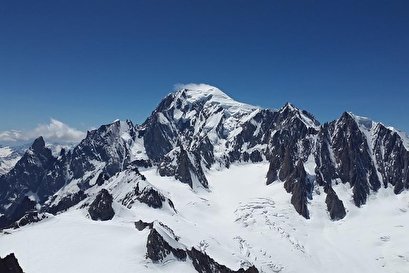TEHRAN, May 14 - Scientists have measured the remnants of Roman-era pollution trapped in the icy layers of the glacier at the top of Dôme du Goûter, a mountain in the Mount Blanc massif, which is part of the Alps.
 TEHRAN, Young Journalists Club (YJC) -The ice cores revealed two peaks in atmospheric pollution from heavy metals. Scientists isolated increases in the presence of lead and antimony related to mining activity and lead and silver production during two separate periods of prosperity in Roman antiquity.
TEHRAN, Young Journalists Club (YJC) -The ice cores revealed two peaks in atmospheric pollution from heavy metals. Scientists isolated increases in the presence of lead and antimony related to mining activity and lead and silver production during two separate periods of prosperity in Roman antiquity.
Researchers linked the first pollution peak to the Republican period, between 350 and 100 B.C. The second peak was linked to the Imperial period, between 0 and 200 A.D.
"The overall pattern of the alpine record during antiquity is consistent with periods of prosperity of the mid‐Roman Republic and Imperial periods that were interrupted by wars and the Crisis of the Roman Republic as documented by historians," Michel Legrand, researcher at the French National Center for Scientific Research, told UPI.
To study the ice-based signatures of the ancient atmosphere, scientists typically rely on cores drilled from Antarctica and Greenland. But the deep-lying ice among the highest glaciers in the Alps also host ancient airborne particles.
Atmospheric signatures in the ice of Antarctica and Greenland best reflect changes at global scales. But Alpine ice records can help scientists study localized atmospheric signatures.
"Alpine glaciers located on industrialized continents like Europe are very useful to scrutinize past changes at the scale of surrounding countries," Legrand said.
Researchers used their latest findings -- published in the journal Geophysical Research Letters -- to compare ancient pollution levels to modern emissions, like the levels of lead released by the burning of leaded gasoline in Europe between 1955 and 1985.
"This alpine ice shows that the lead emissions during the antiquity enhanced the natural level of lead by a factor of 10," Legrand said. "For comparison, recent human activities related to the use of leaded gasoline in Europe enhanced the natural lead level by a factor of 50 to 100. Thus, the pollution by the Romans was some 5 to 10 times less than that due to the recent use of gasoline, but it took place for a long period of time -- several centuries instead of 30 years of leaded gasoline use."
Source:UPI
 TEHRAN,
TEHRAN,